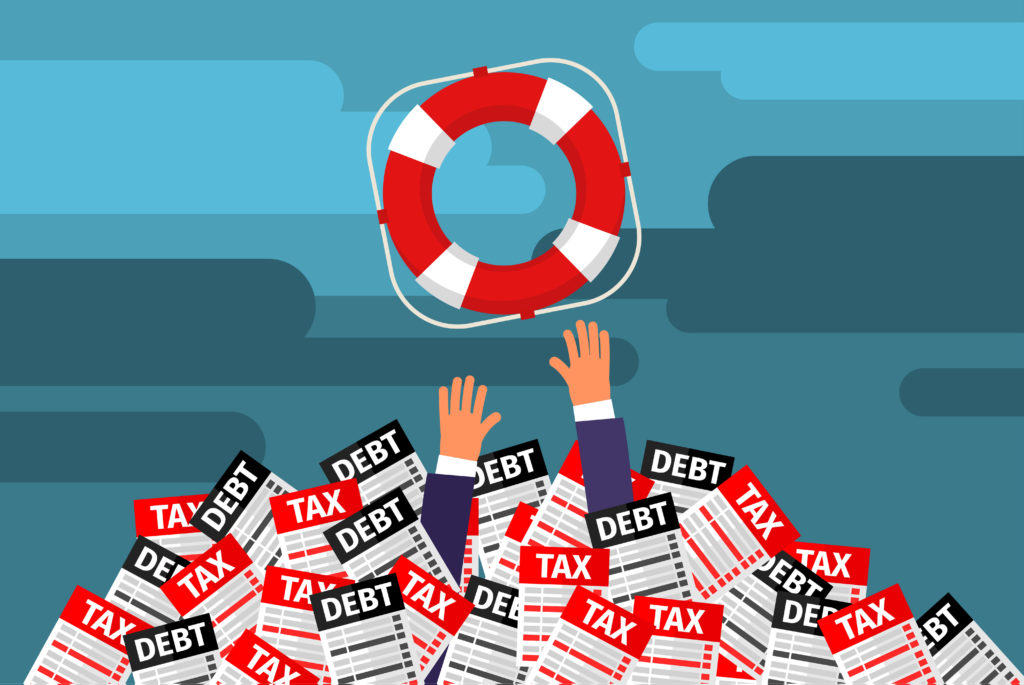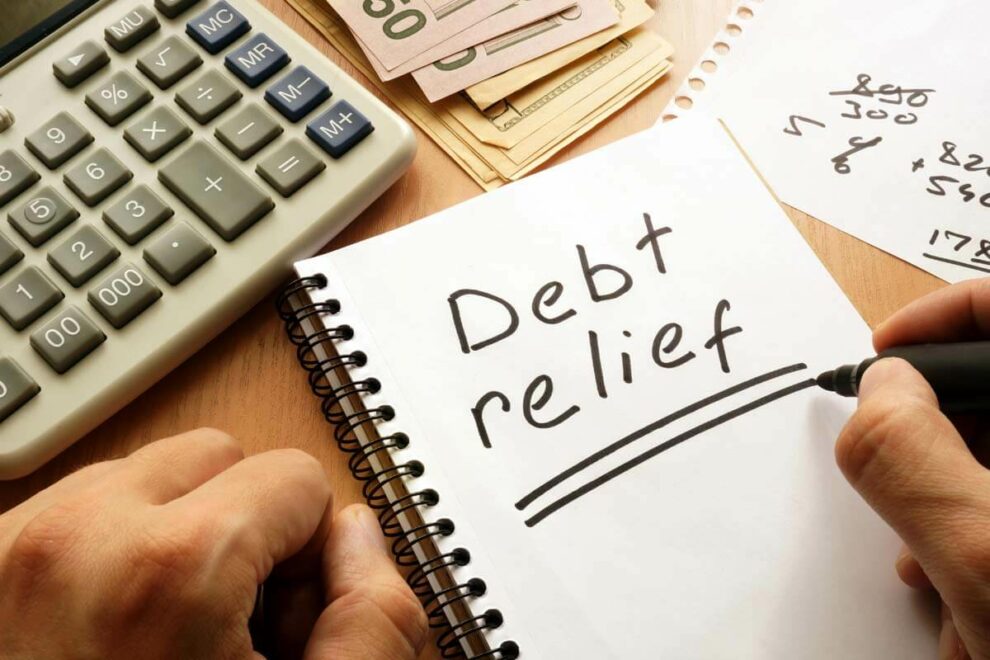Debt relief is the rearrangement of debt in any shape or form to bring relief to the indebted party, either totally or partially. Debt relief can take several forms, including decreasing the outstanding principal amount (either partially or completely), lowering the interest rate on loans due, and extending the loan duration, among others.
Creditors may only pursue debt-relief measures if the consequences of debt default by the indebted party or parties are judged to be sufficiently severe that debt reduction is a better option. Any severely indebted entity, including individuals, small enterprises, huge corporations, municipalities, and even sovereign nations, may be eligible for debt relief.
Working Of Debt Relief
Debt relief may be the sole option for avoiding bankruptcy in various instances. Suppose a huge debt load makes servicing borrowings difficult. In that case, creditors may be willing to restructure the loan and provide relief rather than risk the borrower defaulting and raising overall credit risk. One simple example of debt relief is refinancing a mortgage at a lower interest rate.
Debt consolidation, or consolidating numerous higher-interest loans into a single lower-interest loan, is another prevalent type of debt relief. Consumers can consolidate their debts in a variety of ways. One option is to combine all of their credit card payments into a single new credit card, which can be advantageous if the card charges little or no interest during the promotional period. They may also use the balance transfer option of an existing credit card (especially if it offers a special promotion on the transaction).
Some individuals use home equity loans and home equity lines of credit to consolidate their debt (HELOC). The interest on this loan is often deductible for taxpayers who itemize their taxes. The federal government also offers numerous options for people who want to consolidate their student debts.
Consumer debt is debt due to purchasing consumable or non-appreciable products. Consumer debt in the United States hit a record high of $14.56 trillion in the fourth quarter of 2020, a 1.4% rise from the previous quarter and $414 billion more than the same time in 2019.
An increase in mortgage loans has been linked in part to the rise. Consumer debt relief options include engaging with a creditor about debt-relief measures such as loan restructuring, loan forgiveness, or filing personal bankruptcy, all of which are kinds of debt settlement.
It is crucial to remember that the rules for declaring bankruptcy vary based on the type of debt. If you are thinking about filing for bankruptcy, you should consult with a knowledgeable attorney who specialises in bankruptcy laws in your state. Furthermore, many law offices may provide a free initial consultation.
Debt reduction can help relieve the strain of enormous debt, but it is not for everyone. You’re finding that you’re not progressing on your debt no matter how hard you try? If this is the case, you may be in serious debt.
Examine your debt relief choices to liberate yourself from this financial burden. These options can adjust the terms or quantity of your debt, allowing you to get back on your feet faster. However, debt relief programmes are not for everyone, and it is critical to grasp the implications.
Debt relief may entail completely eliminating the debt through bankruptcy, changing your interest rate or payment schedule to minimise your payments, or convincing creditors to accept less than the entire amount owing.
When should you look for debt relief?

Consider bankruptcy, debt management, or debt settlement if any of the following apply:
- Even if you drastically reduce your spending, you have a slim chance of repaying unsecured debt (credit cards, medical bills, and personal loans) within five years.
- Your total unsecured debt equals half or more of your gross income.
Consider a do-it-yourself plan if you can potentially repay your unsecured loans within five years. This may comprise a combination of debt consolidation, creditor appeals, and stricter budgeting.
Beware of Scam and the negative effects of debt relief
Scammers are ready to grab what little money they have been active in the debt relief market. Many individuals who enroll in debt reduction programmes do not finish them. You may finish with debts that are much greater than when you began.
However, debt relief may give you a fresh start or the breathing space you require to make meaningful progress finally.
Before entering into any deal, be sure you understand—and check—the following points:
- What you must have to qualify
- what fees you will have to pay.
- Who is being paid off, and how much? If your debt is being collected, be sure to know who is responsible for it so that payments may be sent to the right organisation.
- The fiscal ramifications
Debt Relief Disadvantages
Debt relief promote unwise and hazardous behavior by parties who have previously been economically irresponsible. Some people who have been released from debt may go on borrowing binges in the hope that their creditors will eventually bail them out.
Other disadvantages include delaying debt repayment due to consolidation, in which the interest rate is reduced but the repayment period is extended. In general, debt relief techniques might negatively influence your credit score, so use them cautiously.
How to Get Out of Debt: 6 Debt Relief Options
1. Establish and evaluate your budget
If you’re having trouble making your debt payments, chances are you’ve already looked through your budget for places to decrease expenses. This phase might help you spot overspending or uncover recurring expenses that could be stopped or reduced if you don’t have a budget or haven’t kept yours current.
For instance, you can discover that your energy bills are excessive and inquire with your provider regarding discounts. Alternatives include looking into income-driven repayment programmes or temporarily pausing payments through forbearance or deferral until you can balance your financial responsibilities better.
This could be a sensible choice for individuals who:
- Don’t have a budget to aid in managing their debt or haven’t recently revised it.
- Are uncertain of ongoing costs or where their money is going.
- Make sure they aren’t unintentionally increasing their debt.
2. Speak with your lenders
You must contact your creditors to inquire about any unique debt relief alternatives or payment modification plans they may provide. You might get due-date extensions, modified payment plans, or long-term adjustments to your monthly due dates if you communicate with your creditors and explain your status and present difficulties.
A mortgage modification can assist homeowners in keeping their homes. Your remaining debt would be added to the loan amount under this scheme. Then, your repayment schedule would be adjusted by your mortgage lender. Call your card issuer and request that late fees be waived or decreased to make payments more manageable for credit card debt relief.
No matter how you go about it, don’t be embarrassed to seek debt relief. Creditors won’t penalize you for weighing your alternatives.

This could be a sensible choice for individuals who:
- I have not yet discussed debt reduction possibilities with creditors.
- Who might benefit from a modified payment due date or are currently in arrears with their payments.
- Would gain by adding an unpaid obligation to the sum of their loan.
- Possess debt that hasn’t yet been recouped.
- Can regularly spread out smaller payments over a longer time.
3. Look for credit guidance
Nonprofit organizations provide credit counseling, usually called debt counseling, which tries to assist clients with managing their finances and debt.
When you deal with a credit counselor, they could assist you with creating and reviewing your budget, assisting you in setting up a payment schedule, and even negotiating with your creditors to halt collection efforts and delay costs through a debt management program.
This could be a sensible choice for individuals who:
- Are unsure of where, to begin with debt management.
- Like seeking out skilled, objective professionals for budgeting and financial assistance.
- They require more tools to help them take control of their finances.
4. Join a Program for debt management
Debt management plans are frequently provided by credit counselling firms. These plans combine monthly debt payments into one lump sum paid to the counsellor, who then sends the money to your creditors. To help you better manage your debt, the counsellor negotiates with your creditors to possibly cut interest rates and waive or reduce costs.
Debt elimination is the main goal of debt management plans, which normally last three to five years. Unless your family income is less than 150% of the federal poverty line, remember that some plans can have a setup and monthly charge.
This could be a sensible choice for individuals who:
- Feel buried under a mountain of debt obligations each month.
- Are prepared to adhere to a payment schedule for a minimum of three years.
- They are at ease cancelling their credit lines to prevent taking on more debt throughout the programme.
5. Refinance your debt
Consumers can independently reorganize their debt through debt consolidation by obtaining a new loan or line of credit and using it to pay off their previous obligations. This debt relief strategy aims to reduce overall expenses and speed up repayment by replacing high-interest debts with lower-interest loans or lines of credit and consolidating debt into a single payment.
Selecting a new repayment period is another significant advantage of debt consolidation. You may lower your monthly payments with a loan by choosing a longer payback period. This would increase your overall interest rates and lengthen your debt time, making payments more manageable. On the other side, a shorter payback period would result in higher monthly payments but lower overall borrowing costs and a quicker exit from debt.
A debt consolidation loan often referred to as a personal loan or a balance transfer credit card is commonly used for debt consolidation. But you may combine your debts by utilising other products, such as a home equity loan.
This could be a sensible choice for individuals who:
- Can get a loan or credit line with more inexpensive conditions than they are now paying.
- After consolidating their existing debt, they could prevent incurring new debt.
- Can fulfill the conditions of the new credit account or loan.
6. Take into account debt relief
When done on your own, debt settlement can be a practical approach to lowering your debt. Consumers may negotiate their debt settlement by contacting their creditors and suggesting altered payment schedules along with decreases in fees, interest, and occasionally sums.
Third-party debt settlement schemes are possible, but they should typically be avoided. To get creditors to agree to a smaller repayment amount, these programmes require you to stop making payments. However, there is no assurance that this tactic will succeed, which will undoubtedly damage your credit. Additionally, these programmes have exorbitant costs and are frequently full of fraud.
This could be a sensible choice for individuals who:
- Spend some time talking to your creditors.
- Can monitor the results and agreements of outreach.
- Are capable of proving to creditors that they are currently experiencing financial difficulties.
FAQs
What exactly does “debt relief” entail?
Debt relief refers to efforts that decrease or restructure debt to make repayment simpler for the borrower. Forgiveness of a portion of the principle, reduction of the interest rate, or consolidation of many loans into a single, lower-interest loan are all options for debt relief.
What are the requirements for debt relief?
A few requirements must be met to qualify for National Debt Relief’s settlement program. You must be more than $7,500 in debt and many months behind on payments. Additionally, you must be able to make agreed-upon monthly payments to National Debt Relief.
Is the programme for debt relief real?
National Debt Relief is a reputable debt relief organization. It has a staff of professional debt arbitrators from the International Association of Professional Debt Arbitrators.
Is it possible for me to undertake my own debt relief?
You certainly can. You’ll need to dig deep into your spending patterns, budget, and debts. It also entails contacting your creditors and demanding lower credit card interest rates and fees. Although this may appear difficult, many banks are eager to deal with individuals and will accept your call.










Add Comment